The Vision
When discussing music, songs can typically be classified into most genres according to things like instrumentals, vocals, or other musical elements. However, deciding that a song is a protest song does not have to go through this same process. Protest music can be folk, rock, rap, or any number of different genres. If that is the case, then how do we actually identify what protest music is?
Our research project focused on identifying distinguishable linguistic features of American protest music and its lyrics. We know that in these songs, all types of genres can work as protest songs. This motivated us to turn towards the lyrics. We wished to answer the following question: can an American protest song be identified by linguistic elements found in the lyrics?
We approached this question by analysing three time periods in America:
- The Great Depression (1929 - 1939)
- The Vietnam Era (1960 - 1975)
- The Contemporary Era (1975 - Present)
We compared lyrics to non-protest lyrics from the same time periods. We tagged the lyrics syntactically, labelling noun phrases, verb phrases, and adverbs, and noted when a phrase is negated in certain instances. We looked at the various phrases to see if there were distinct differences in syntax between the protest songs from one time period versus the non-protest songs from that same period. We used statistical analysis to determine if these differences were, in fact, significant. With this, we wished to discover that although protest music may not be identifiable by a single musical style, it can still be identified by properties found in the lyrics.
To gain further understanding of what each protest song is referring to in our project, please read about the different eras in America below.
The Method
At first, a lot of people will try to define protest music in terms of its content: it seems that in a lot of American protest songs, there is reference to a specific war or current event that upsets the artists at hand. However, using a definition of this sort has two potential errors. First, it can make an argument very circular in nature. Saying that a song has to incorporate war or current events does not leave room for protest music to grow or evolve over time. Any future songs that might still be protest songs, but do not have the appropriate content based off this type of definition, will be improperly disregarded. Another error is that it can allow in too many songs as proper candidates. There is still the option that songs can be created where an artist is upset about a situation at hand but isn't necessarily protesting anything.
Our group wanted to turn away from this method of explaining protest music. Therefore, we turned to the syntax of song lyrics, rather than its content. We wanted to see if this could reveal significant differences in how an artist sings when one is protesting versus when one isn't.
To do this, we looked at 10 of the most popular songs from each era that were not considered "protest" songs by outside sources. We also looked at 10 of the most popular songs from each era that have been labeled as protest songs by outside sources. We used XML markup and tagged the songs according to a synatctical hierarchy; these rules closely resembled what one would find in X-Bar Theory, with a few modifications. To start, we did not see reason to tag everything, such as conjunctions. We also decided to not tag every phrase, such as adjectival and adverbial phrases, but instead just tag the adjectives and the adverbs. Linguistic data is extremely tedious and time-consuming, and because of this, we tagged parts we wanted to study within the limited amount of time we had, rather than tag everything. If we had more time to continue with this project, we would continue to mark up each and every phrase and observe more and more components of the lyrics.
In summary, we decided to study nouns, noun phrases (while also tagging determiners), verbs, verb phrases, adjectives, adverbs, prepositions, and prepositional phrases.
One issue with this method comes into play when there are noun phrases that consist of just determiners. Whereas some theories want to make determiners the head of phrases, and thus call them determiner phrases, we decided to go against this theory and keep everything as noun phrases - even the phrases that did not have nouns in them. We did this for two reasons. One, we needed equal participation from all team members, and so we needed to keep tagging comprehensive for members who did not have a linguistic background. There was a higher chance of error in identifying phrases based off their determiners versus their nouns, since it is more obvious to identify a noun as a non-linguist. Second, we wanted the project to very comprehensive for users on our site who are also non-linguists. We did not want confusion as to what a determiner phrase is or what it meant; it is more comprehensive to identify a noun in the lyrics and then see the overarching phrase of which it is a part.
For each line, we tagged a noun phrase and a verb phrase as the overarching child elements. We then tagged the noun phrases to allow nouns, determiners, adjectives, and adverbs. We tagged verb phrases to allow verb phrases, noun phrases, prepositional phrases, and all of their child elements. This is a result of our modification to X bar theory. Instead of labeling overarching verb phrases as V', or V-bar, we tagged them as verb phrases on top of verb phrases instead. This still preserves the hierarchy of different verbs in each line, without making it too incomprehensible for non-linguist users and researchers. This same concept applies to our prepositional phrases, labeling each as a phrase rather than incorporating P', or P-bar, and instead calling them phrases. Prepositional phrases could have prepositional phrases inside them, along with verb phrases, noun phrases, adverbs, adjectives, and all of their child elements.
Therefore, we also eliminated the use of N', Adj', and Adv' based on similar principle. Though we wanted to label the hierarchy of nouns, verbs, phrases, etc. in the lines, we wanted to do it in a way that did not make the data too overwhelmingly complicated.
We wanted to mark when negation words, such as the word "not"
were found within certain phrases. We gave noun phrases and verb
phrases the option to be tagged neg="true", signaling in the data
that a word such as "not" was present.
There are two final notes. The first is that participles were not marked as distinct parts of speech. Instead, the participles were grouped with the verbs with which they were associated and tagged under a single verb element.
The second is that refrain sections (chorus sections) were tagged only once. This is to reduce the number of repeating words and phrases in the song. We did not our results to be skewed by one or two lines that repteated constantly throughout the duration of the song.
The Eras
Great Depression
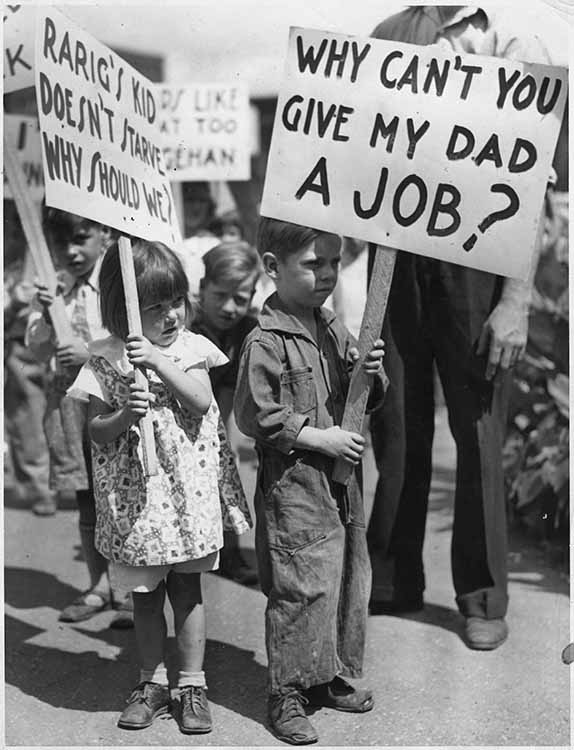
The Great Depression is noted as one of the deepest and longest-lasting economic downturns in the history of the world. The Great Depression began in the United States after the stock market crash in October of 1929. In 1933, during the lowest point in the Great Depression, 13 to 15 million Americans were unemployed. The economic plight of the Great Depression lasted
African Americans were the hardest hit group of people during The Great Depression; half of all African Americans were unemployed in 1932. In some Northern cities, whites called for blacks to be fired from any jobs as long as there were whites out of work. Violence towards African Americans, such as lynchings, became more common again during The Great Depression. During this period, white supremacist groups such as the Ku Klux Klan were at the height of their prowess.
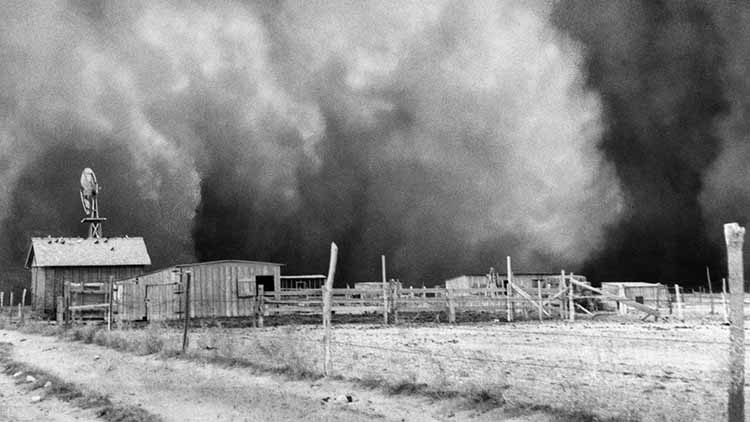
During this time, the Great Plains region suffered from a drought from 1934-1937, known today as the Dust Bowl. An extended drought and overuse of land rendered the top layer of soil to dust. Heavy winds then blew the topsoil in places like Oklahoma, Kansas, Colorado, New Mexico, and The Texas Panhandle, creating dust clouds called 'black blizzards.' Sixty percent of the people fled the region during this time as a result. The Dust Bowl was most devastating famine in United States history. Artists, from authors to singers, expressed the need to be in harmony with nature, rather than try to dominate and exploit it.
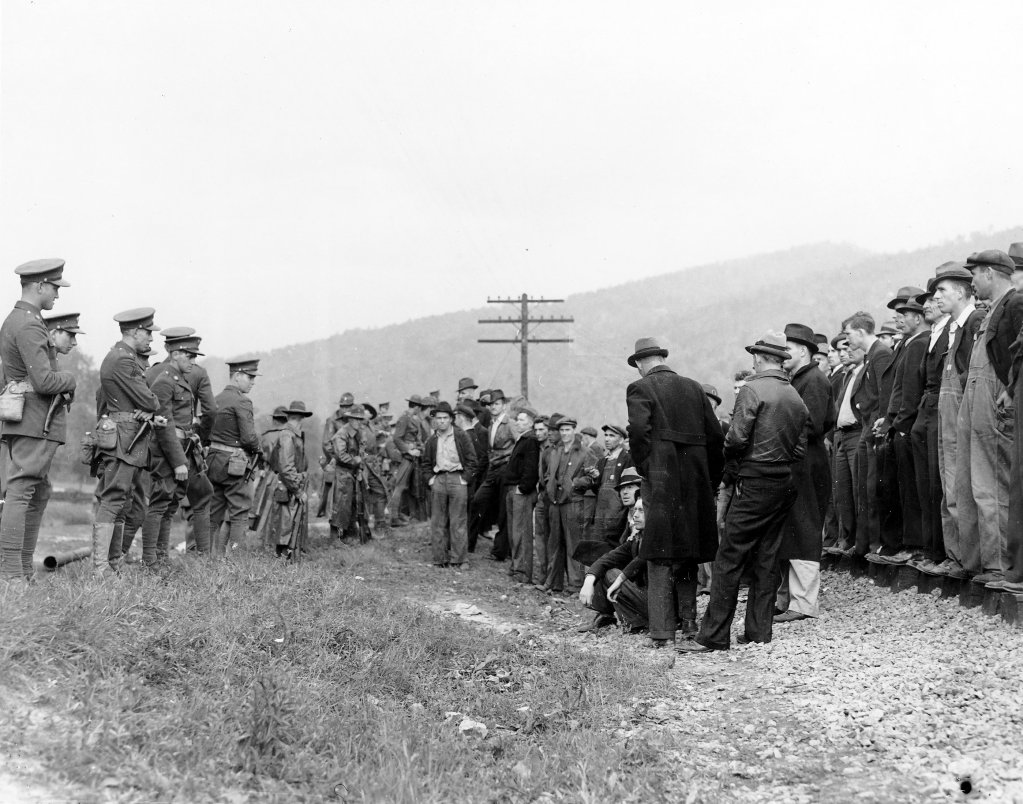
Finally, the Harlan County War took place from 1931-1932. This was a series of coal mining-related skirmishes, executions, bombings, and strikes that took place in Harlan County, Kentucky, during the 1930s. During The Great Depression, miners were making as little as eighty cents per day. The workers went on strike for better wages and better working conditions.
The Great Deprssion presents a fascinating time in American protest music. In the early stages of the era, the American people were rife with discontent. People believed the American government had truly failed to protect them from the excess of capitalism. Everybody was struggling, but the poor struggled the most. Songs such as Brother Can You Spare a Dime scoffed at the notion of the American Dream, which had long been the beacon of hope for the poor. The era progressed in an interesting fashion as well. In 1932, Franklin Roosevelt was elected to the presidency. He brought the American people a breath of fresh air, as well as the New Deal. The New Deal created an economic and social safety net and created millions of jobs in order to put as many unemployed as possible back to work. A noted instition created by the New Deal was the Works Progress Administration (WPA). Noted names such as Woody Guthrie recieved funding from the WPA to produce music. One could perhaps say that during the Great Depression, the government funded the writing of protest music.
Vietnam
The Vietnam era truly represents a golden age of American protest music. Though it is termed in this project as the Vietnam era, it really consists of two major events. First is of course, the Vietnam War, which lasted for nearly 20 years, from 1955 to 1975. Second is the Civil Rights Movement. The Civil Rights movement has existed in some form throughout much of American history, but for this project, we will focus on the events that transpired in the 1960s. Thus, in terms of the scope of this project, the Vietnam era covers the years from 1960 to 1975. This era witnessed the composition of some of the most popular and famous protest music in history.
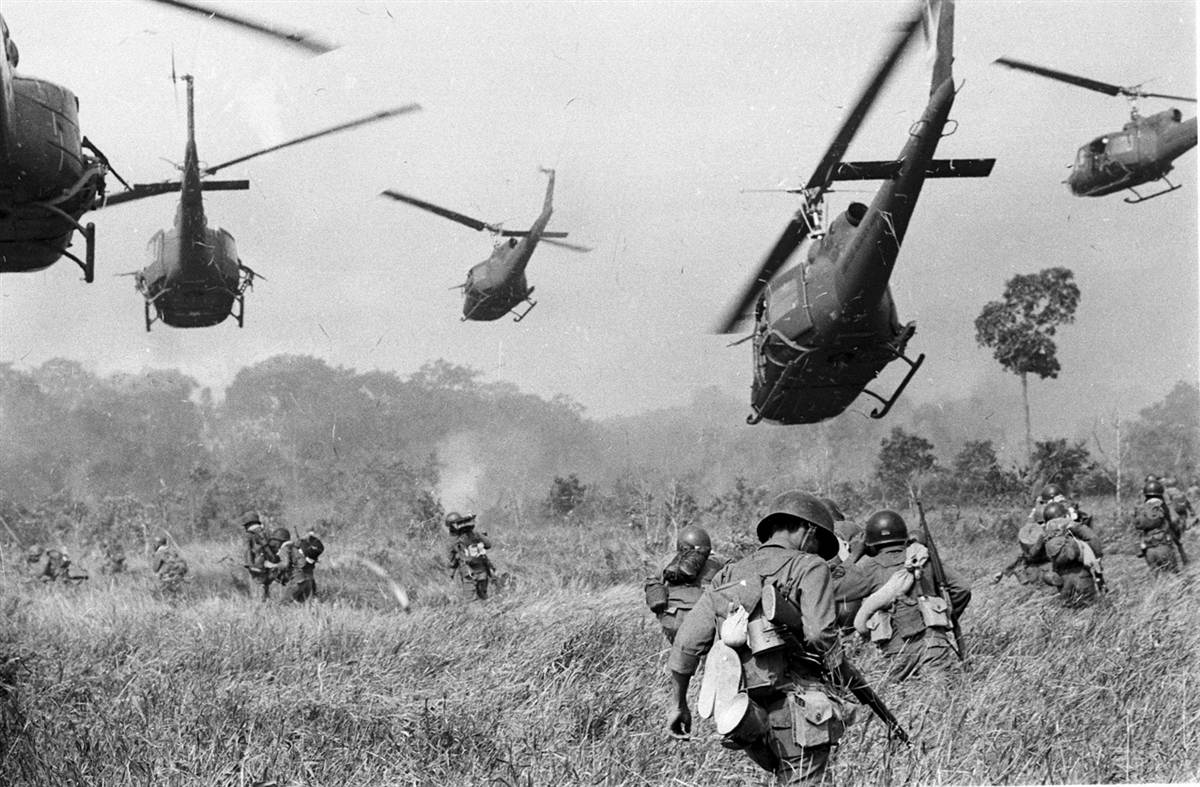
The turmoil of the era was an incubator for the outburst of protest music seen in this era, especially when compared with the relatively tranquil 1950s. The dialogue of the protesters in the early years of this era was generally mild. Songs like Bob Dylan's Blownin' in the Wind projected a profound message of pacifism that transcended a mere opposition to the war in Vietnam. As the decade progressed, the protesters became more and more tense. Meaningful change was either not occurring, or not occurring quickly enough. A sense of impatience set in around the country.
This impatience turned to shock and anger as this era drew into its latter years. Popular figures like Martin Luther King Jr. and Robert Kennedy were killed by the bullets of assassins. The Civil Rights movement had largely descended into violence. The Vietnam War had seemingly no end in sight. Protester clashed with police in Chicago outside the Democratic National Convention.
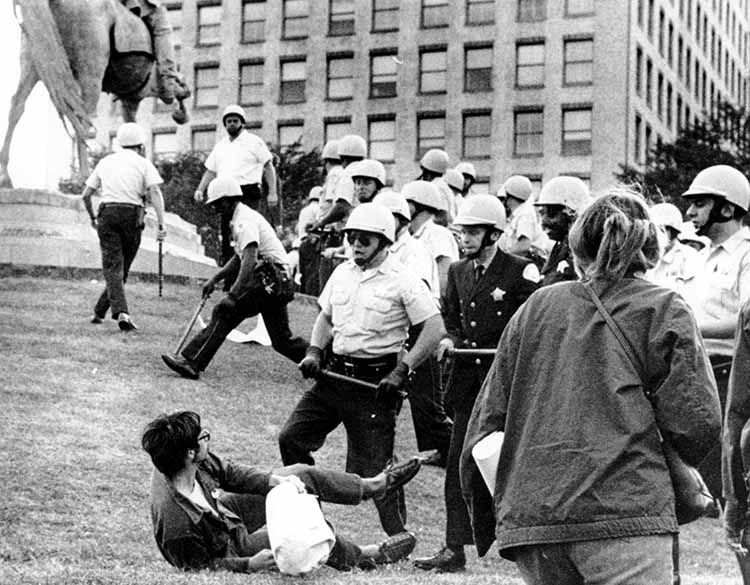
In addition to the thousands of American soldiers killed, the war had destroyed a president. The new president, Richard Nixon, promised to end the war in Vietnam, although his actions, such as the invasion of Cambodia further incited the protesters.
By the end of the decade, country was at the boiling point. Many of the protesters were college students, so many protests took place on college campuses. On May 4th, 1970, one of these protests took place at Kent State University in Ohio. The Ohio State National Guard was summoned onto campus once the protests on campus, and eventually fired on the protesters, killing four students and wounding nine. The Kent State massacre received a plethora of media attention, and photographs of that day were sent to newspapers worldwide. This event inspired Neil Young to write the song Ohio, which uses an angrier rhetoric than the songs that characterized the early era, going as far as accusing Nixon himself.
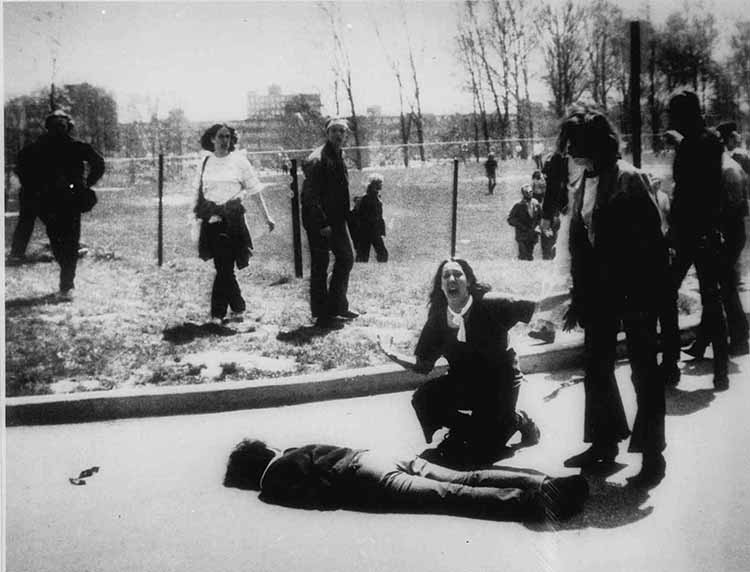
Protest music characterized the 1960s. Polarizing issues like Civil Rights and the Vietnam War made for popular song topics. The protest culture of the era centered primarily on the youth. No other group of youth in American history has been more politically active than the protesters of the 1960s. While their actions have been largely discredited in the ensuing years, they gifted upon us some of the most influential protest over written.
Modern
For this project, we defined the Modern Era as any time after 1975, which was the official end of the Vietnam War.
After the loss in Vietnam, veterans from the war were not treated with respect when they returned home. Unlike the World War II veterans, who were seen as heroes, the Vietnam Veterans were 'baby killers,' 'psychos,' 'drug addicts,' and 'war mongers.' Veterans were extremely mistreated; they were refused service at restaurants, and they were cursed at by anti-war Americans. Protesters would stand at the gates in airports protesting against the war as Vietnam veterans returned home. Bruce Springsteen depicts the Vietnam Vet in 'Born in the USA:' Springsteen explains that, 'He's isolated from the government, isolated from his family, to the point where nothing makes sense.'
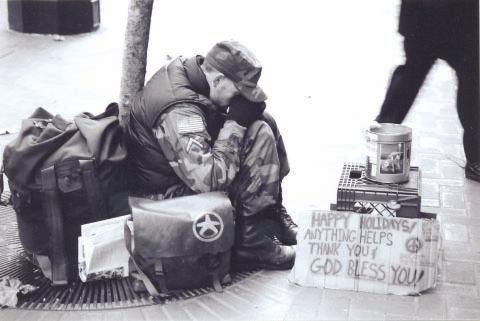
On November 6th, 1990, the state of Arizona voted down to create a holiday for Dr. Martin Luther King, Jr. Two years prior, the governor was Evan Mecham, who cancelled Martin Luther King day saying, 'I guess King did a lot for the colored people, but I don't think he deserves a national holiday.' In 1991, Public Enemy produced 'By the Time I get to Arizona' as a response, and the message spread -- in part because it was aired on MTV. By 1993, Arizona lost its chance to host the Super Bowl. Arizona lost $350 million in revenue before reinstating MLK day in 1993.
On February 4th, 1999, Police officers in New York City fired 41 shots at an unarmed, West African immigrant who had no criminal record. The immigrant's name was Amadou Diallo, he was 22 years old, and he worked as a street peddler in the city. Bruce Springsteen wrote his song 'American Skin (41 shots)' about this police shooting.
In 2013, Springsteen dedicated his song to Trayvon Martin. Trayvon Martin was as 17-year old African American who was shot by George Zimmerman in 2013 while he was out running errands at a convenience store. Both the New York City police and George Zimmerman noticed the men in each case late at night and declared that they looked suspicious.
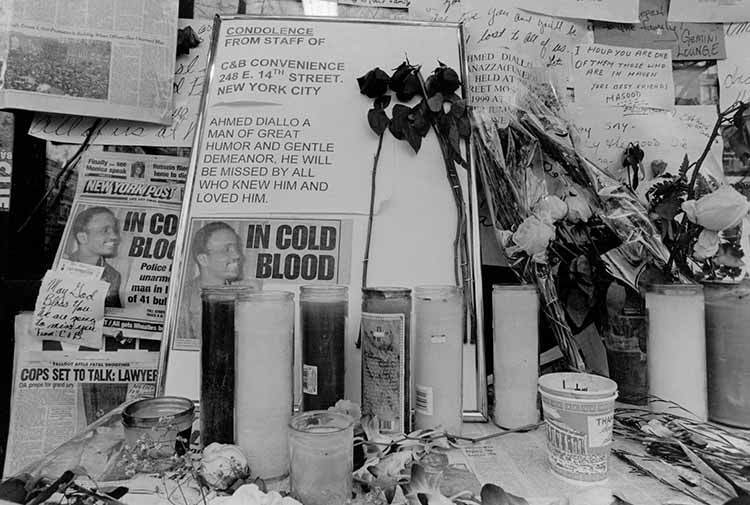
In 2008, musicians were protesting against the war in Iraq, which went from 2003 until 2011. The Iraq war was constantly justified by Washington as 'a preventative military action' against a country that could use 'weapons of mass destruction' (WMDs) against the United States. Prior to the attack, no WMDs were found in Iraq. Many people opposed this strategy. Former president Bill Clinton warned of the consequences of a preventative invasion, as such action may lead to unwelcome consequences in the future. At one point he said, 'I don't care how precise your bombs and your weapons are, when you set them off, innocent people will die.' Many theories went around as to why the United States really wanted to invade Iraq. Nelson Mandela, former president of South Africa, voiced his opinion of president George W. Bush; he believed that, 'All [Mr. Bush] wants is Iraqi oil.' Many believed that the Iraq War was putting Americans through unnecessary traumatic experiences via military involvement - Americans were risking their lives and killing what seemed to be innocent people for perhaps no good reason at all. Many compared parts of the Iraq war to the war in Vietnam, and many people protested against the war as a result. Between January 3rd and April 12th, 2003, 36 million people across the globe took part in almost 3,000 protests against war in Iraq, with demonstrations on 15 February 2003 as the 'largest and most prolific of them.'
As a result, protest music during this time expressed this viewpoint. In 2012, Tim McIlrath, the lead singer of the band Rise Against, sang his song Hero of War outside of the NATO summit in Chicago. His song depicted an Iraq War Veteran remembering his experiences in the military during this time. His song is meant to remind listeners of the perspective of the soldier. The United States does not simply send in weapons to shoot targets; Americans are getting severely injured and killed while injuring and killing other human beings in the name of their country.
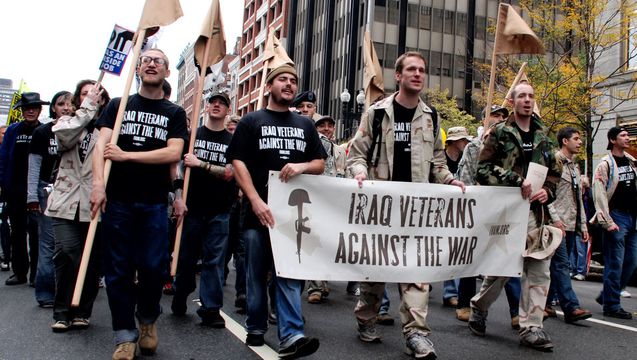
The modern era, like every other era, wanted to change the way African Americans were treated. Americans protested against multiple issues they had with the United States government. One thing to note in this era more so than the others is that protesters highlighted not just one event in history, but many - pointing out the flaws in our actions across time. This typically happens when discussing methods that the United States used in order to dominate in wartime.
The Analysis
After completing the markup of the songs, we began exploring ways of analyzing the marked up text. Our objective was of course to determine whether or not there was a general linguistic difference between the group of protest songs, and the control group of non-protest songs. The question for us became, how does one quantify linguistic differences?
A principle that was immediately clear was that all froms of subjectivity had to be limited as much as possible. This ruled out all forms of "sentiment" analysis. We simply could not afford to do something like marking up ideas within the texts, because they could be open to interpretation. One person's interpretation of a song could be very different from anothers, which would discredit any data that we collected. Instead, we looked for something more concrete. Something that could be easily intrepreted in black or white, rather than shades of grey.
In our original markup of the texts, we marked up both verb phrases and noun phrases. A noun phrase can consist of many words but only truly requires a single noun or a single determiner, similar to a verb phrase, which only requires a single verb. However, more words in these phrase can add description. The use of desciption in these phrases colors the meaning of the phrases, invoking emotions in the audience that would not be possible without the descptive words. The primary desciptive word in a noun phrase is an adjective, while in turn, the primary descriptive word in a verb phrase is an adverb. We decided to simply test for the presence of these primary descriptive words. A further test we invoked was for the presence of negation in both verb phrases and noun phrases. Negation and primary desciptive words were coded as different variables. For example, if a noun phrase did feature negation but did not have an adjective, it was coded as a "1" in negation and a "0" for adjective. Similarly, if a verb phrase featured both negation and an adverb, it as coded as a "1" for both.
After compiling the data from the songs, we performed a probit analysis on the collected data in order to check to see if there was a statistical difference between the protest song data, and the nonprotest song data. We additionally made graphs for the data from each song, which helped to paint individual picture for each song.
Us
This research project was completed by David Galloway, Leonidas Pashos, and Katie Uihlein. This project was performed at the University of Pittsburgh. This project was for a class called Computational Methods in the Humanities, taught by Dr. David Birnbaum.
